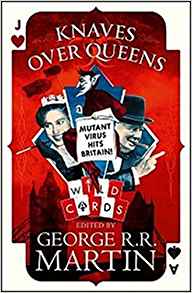Paula Guran Reviews Knaves Over Queens, Edited by George R.R. Martin & Melinda M. Snodgrass
 Knaves Over Queens, George R.R. Martin & Melinda M. Snodgrass, eds. (HarperVoyager 978-0008283599, £16.99, 550pp, hc) June 2018. (Tor 978-1250168061, $29.99, 560pp, hc) August 2019.
Knaves Over Queens, George R.R. Martin & Melinda M. Snodgrass, eds. (HarperVoyager 978-0008283599, £16.99, 550pp, hc) June 2018. (Tor 978-1250168061, $29.99, 560pp, hc) August 2019.
This 27th book in the laudable (but often underestimated) Wild Cards series is the first to focus solely on the British Isles. The cycle’s long history now spans more than three decades (since 1987) in publishing time and more than seventy years in fictional chronicling. There are so many major characters, not even the fan wiki or official website has been able to keep track of all them and Knaves Over Queens introduces even more (at least a dozen by my count). Wild Cards is a rich brew for readers, but offers the editorial challenge of keeping longtime fans happy while attracting new ones. Knaves Over Queens offers a lot for both, but may not please all.
For those who don’t know: the Wild Card universe departs from ours in 1946 when an alien virus arrives on Earth. Ninety percent of those who contract it die; the DNA of the ten percent who survive it is altered. Nine percent acquire debilitating mutations and become known as jokers. The remaining one percent, aces, gain unique superpowers. There’s also an uncounted number of those dealt a mixed hand: joker-aces. They acquire a handy new nickname, “knaves,” in Knaves Over Queens (although I’m not sure how well that works for female joker-aces).
Kevin Andrew Murphy establishes the 1946 British milieu for the anthology/mosaic novel as the alien wild card virus strikes the Queen Mary with “A Flint Lies in the Mud”. The initial plotline involves the genesis of previously established ace, Captain Flint, a stone giant. A second Murphy story set in 1952, “But a Flint Holds Fire”, features Captain Flint and the establishment of the Order of the Silver Helix by Queen Margaret, Winston Churchill, and Alan Turing. Flint goes after a new character: the thieving Spring-heeled Jack. Imaginative and entertaining as the stories are, Murphy’s efforts at making the tales “English-y,” his exclamatory style and frequent delivery of large chunks of information make for a rocky start for those seeking top-notch writing.
Between the two Murphy stories, we have Irish author Peadar Ó Guilín with “The Coming of the Crow”, set in 1952 Donegal. He introduces Anya, a young lass whose powers lead her to identify as Badb, a goddess of war. Her story is continued later in the book with “Cracks in the City”, set in 1987 Belfast, and the volume-ending “Feeding on the Entrails” (2017). Badb’s bloody nature and her involvement with the Troubles will appeal to anyone with a sense of history, but with only a part of the story in the content’s second slot – necessitated by the need for chronology – it challenges the reader’s ability to invest in the volume.
Things take off, however, with Caroline Spector’s “Needles and Pins”. It is 1967 and we meet a seamstress – friend of a lycanthropian Mick Jagger – whose wild card is making indestructible clothing. The murderous Kray twins are the villains. They’ll be known to true-crime fans, but non-Brits may not appreciate their basis in our world.
With “Night Orders” by Paul Cornell, one begins to realize these are strong narratives, not just superhero-action stories. Captain Lightning – Secret Service analyst Charlie Soper – is the protagonist of this pleasingly plotted lowkey 1973 spy drama concerning a plot to assassinate the increasingly unstable Churchill.
Charles Stross’s “Police On My Back” is set in 1981. It’s a bit of a love story between a knave with power over concrete, brick, and stone, and Jenny, a three-armed joker who works undercover for the police. Nasty gangsters must be dealt with.
The Silver Helix dispatches Sub-lieutenant Rory Campbell and Major Ramjit Singh to aid the British in the 1982 Falklands War in Marko Kloos’s “Probationary”. They prove helpful as Campbell can remotely disable electronics and Singh is the super-strong Lion. (Will US readers remember the Falklands or get the reference to the Lion of Punjab?)
In 1984, the wild card virus leaves conservative Roger Barnes, a speechwriter for Margaret Thatcher, with wooden skin. According to Peter Newman’s “Twisted Logic”, Barnes goes undercover at Churchill’s behest in order to bring down the Twisted Fists, a terrorist organization that retaliates against those who attack jokers.
“Ceremony of Innocence” by assistant editor Melinda M. Snodgrass explores the first mission (1996) of shapeshifting and teleporting ace Noel Williams. Recruited by Captain Flint and Alan Turing, he becomes Double Helix. Double Helix, a powerful teleporter who can be male or female, is one of the most interesting of the aces, so another adventure is welcome.
Emma Newman’s poignant “How to Turn a Girl to Stone” takes place in 2003-2005 in Cornwall. To young Kerry’s dismay, she can turn living creatures into stone. Learning of an ace who can reverse the procedure gives her hope, but the knowledge only allows her parents to take further advantage of her powers.
“The Visitor” by Mark Lawrence is set in 2017. Tetraplegic since birth, 17-year-old Angela cannot speak, but she is mentally perceptive. When she survives the wild card virus, she acquires the power to “visit” other people’s brains. Other than telling the story of Angela’s ace adaptation and her effort to right a wrong, the story offers some insight into a couple of jokers who were so afflicted by the virus they have been institutionalized
All-in-all, it’s another great journey into the Wild Card universe. Fans who are Anglophiles and/or natives of the UK will be delighted with Knaves Over Queens. So will those with a penchant for deconstructions of the superhero trope and for atypical heroes. Even with Murphy and Snodgrass treading known turf, US fans with a long-term commitment to the series and a desire to see more about jokers and aces they already know, however, may not be as happy.
Paula Guran has edited more than 40 science fiction, fantasy, and horror anthologies and more than 50 novels and collections featuring the same. She’s reviewed and written articles for dozens of publications. She lives in Akron, Ohio, near enough to her grandchildren to frequently be indulgent.
This review and more like it in the December 2018 issue of Locus.
 While you are here, please take a moment to support Locus with a one-time or recurring donation. We rely on reader donations to keep the magazine and site going, and would like to keep the site paywall free, but WE NEED YOUR FINANCIAL SUPPORT to continue quality coverage of the science fiction and fantasy field.
While you are here, please take a moment to support Locus with a one-time or recurring donation. We rely on reader donations to keep the magazine and site going, and would like to keep the site paywall free, but WE NEED YOUR FINANCIAL SUPPORT to continue quality coverage of the science fiction and fantasy field.





